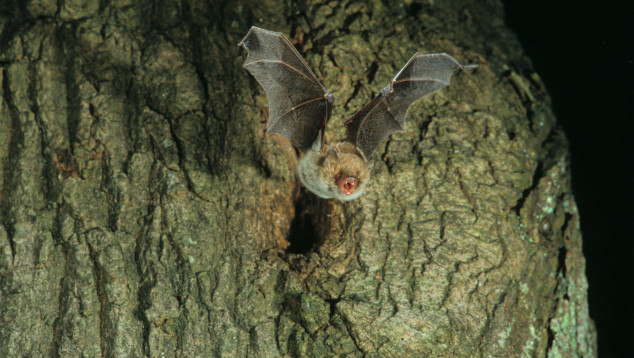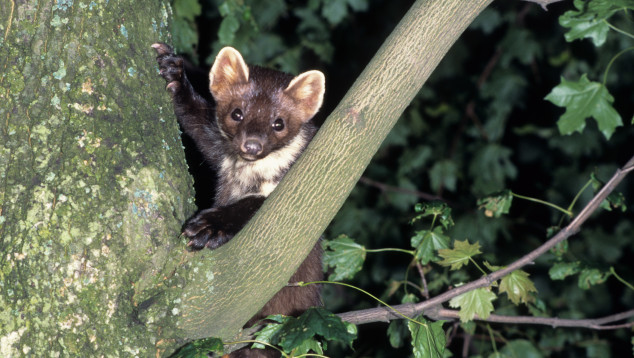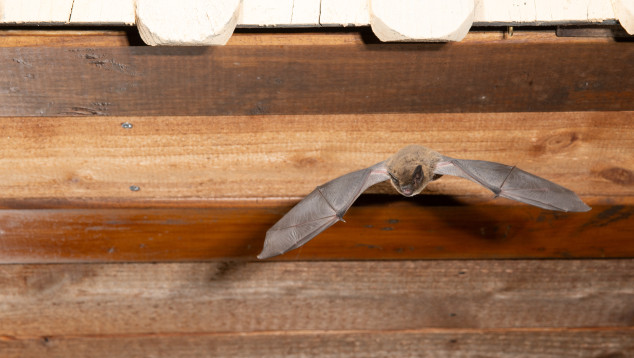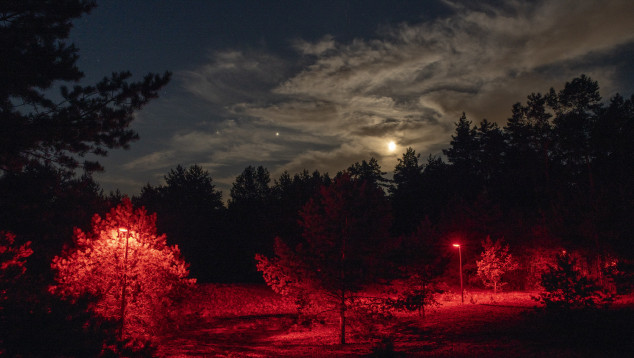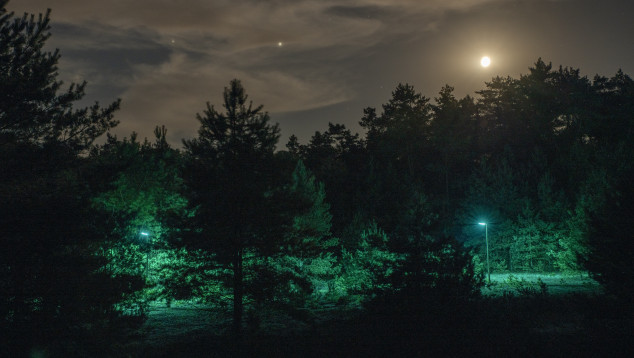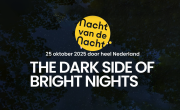Shining a light on nature – the importance of darkness
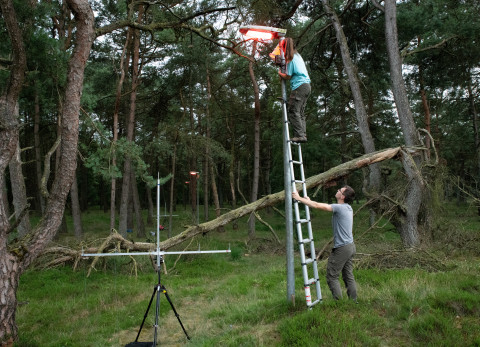
Since 2012, the Netherlands Institute of Ecology (NIOO-KNAW) has been conducting research into the effect of artificial light at night on our natural environment. For this research – Light on Nature – streetlights have been installed at four locations in the Veluwe and one location in Drenthe. Since then, they have been lit year-round from sunset to sunrise. Various institutes, universities and organisations are using these streetlights to measure the effects on different species groups.
It is less and less dark at night. This is because us humans rely on what we can see and therefore like to light up our surroundings. The surface of the earth that is illuminated at night more than by the full moon – which is only visible occasionally – is increasing by more than two per cent per year. The recent transition to energy-efficient LED lighting has accelerated this effect. It is, of course, good that this lighting is more economical, but because its use also saves money, extra lamps are often installed.
Nocturnal animals
Artificial light at night is a problem for many species in our natural environment. Logically, nocturnally active animals are the most affected, as they depend on darkness. For most of these species, it is important not to be seen so they will not be caught by predators. Bats are a good example: most species fly relatively slowly, which is dangerous if you are visible. They therefore wait to fly out – leaving their hollow tree or shelter in a building – until it is sufficiently dark outside. Species that can fly a little faster or are very agile dare to leave their colony earlier, when it is still a little light. Species that fly the slowest wait until it is completely dark. It is precisely these slow flyers that avoid artificial light the most: bats of the genera Myotis and Plecotus are not often found near illuminated areas. This means that they lose part of their hunting ground. Typical examples of these species are the Natterer's bat (Myotis nattereri), Daubenton's bat (Myotis daubentonii) and the brown long-eared bat (Plecotus auritus).
Ecological trap
For fast and agile bats, such as the common pipistrelle (Pipistrellus pipistrellus), the effect of light often seems to be reversed. Although they do not like light, they are not particularly afraid of it and like to forage around lamps for insects attracted by the light. This effect is not difficult to observe: if you stand next to a streetlight in the summer with a bat detector – which makes the very high-pitched sounds of bats audible – you will often hear the characteristic sound of a pipistrelle. However, there are increasing signs that the easy catch of insects attracted by light is an “ecological trap”. While it is beneficial in the short term, in the long term there are fewer insects in areas with streetlights. This is also disadvantageous for pipistrelle bats. We also measured this around the experimental lighting of the Light on Nature research: the amount of moths in the vegetation directly around the streetlights decreased after a few years.
Attracting versus repelling
Nighttime artificial lighting is particularly harmful to insects that fly at night: they are highly mobile and are attracted to light. Examples include the aforementioned moths, but also water beetles (which often fly at night), mayflies, typical bugs and various species of flies. Exactly how attraction to light works is not yet fully understood. It is generally assumed that insects orient themselves to a light source, such as the moon or bright stars. Because these are very far away, the position of such a light source remains relatively constant, even when the insect moves around in the landscape. In the case of a much closer light source, such as a streetlight, the position of that source changes immediately as the insect moves. This causes the insect to automatically fly around the lamp. Another, recently proposed theory is that insects tilt the upper part of their bodies towards a light source. This causes them to fly in circles, just like an aeroplane does when turning.
Other nocturnal species that dislike artificial light at night include – back to mammals – mice and martens. Their activity was measured using automatic cameras placed around the experimental lights. Wood mice take the crown when it comes to avoiding light: they are strictly nocturnal and do not show themselves, even when there is only a little light. Voles, which eat less nutritious food and therefore need to eat more often and also forage during the day under natural conditions, have less trouble with light.
Restless great tits
Not only nocturnal species are affected by artificial light. Species that are active during the day like to sleep at night. Using miniature transmitters, we have shown that great tits that have their night-time roosts near the experimental lamps are restless throughout the night. This restlessness is obviously not beneficial. Another effect that became apparent is that light close to a great tit nesting box can cause the tits to start breeding earlier. This effect only occurs in cold springs. Great tits wait for warmer weather, but if that takes a long time, it is conceivable that the increasingly longer days tell the birds that the chance of warm weather is increasing. A little extra light can make the days seem even longer, thereby “persuading” the tits to start breeding. On the other hand, there are also bird species that actually make use of artificial light, such as nightjars. They are better able to catch moths in locations with a lot of “sky glow”: light that comes from a greater distance and is reflected from the sky, for example near large cities.
Less and different lighting
How can we minimise the impact of artificial light on the natural environment and the species mentioned above? The most obvious answer is to limit its use. Reduce the intensity of lighting on infrastructure and in rural areas and switch off lighting when no one is around. LED lighting offers a solution, as it is easier to dim than most traditional types of lighting that were used in public spaces in the past. Some municipalities, including Rotterdam, are using dimmable lighting on a large scale, which is helping to significantly reduce light pollution.
Another way to limit the effect of light is to use less blue. Many nocturnal animals, such as insects, bats and mice, are sensitive to blue light and perceive light with less blue as less intense. Around the experimental lighting in Light on Nature, we have demonstrated that slow-flying bat species do not respond to red light at all. Red light can be an option to prevent these species from losing their habitat, especially along roads in rural and forest areas. However, in places where these bats are vulnerable to predators, such as at the exit of their shelter, this light can actually be dangerous. The bats think they are in darkness, while owls and martens can see them clearly in the red light and catch them easily.
The red light is very red, which not everyone in residential areas appreciates. A good alternative is to use warm white light with a low colour temperature. That may sound confusing, but the lower the colour temperature, the warmer the light. For example, in France, because of the importance of limiting blue in light, the rule is now not to use colour temperatures higher than 3,000 Kelvin for public lighting. Limiting the amount of blue in the light is also beneficial for insects: blue light attracts insects much more strongly than red light, so reddish light or light with a low colour temperature is better in this case too. Green lighting – with less red – may be less disruptive to birds migrating over the sea at night. Inland, however, green lighting, which can (still) be seen in some places, is not a good idea.
Getting used to it
Yet it remains important to always consider limiting light first. Less or no lighting at all is a matter of getting used to it. People often feel safer when there is lighting, but this is misleading. Take, for example, a lit cycle path through the woods: someone cycling there can be seen from a great distance. Conversely, someone hiding in dark vegetation a few metres from a lamppost remains completely unseen – even by someone cycling right past them. If we learn to move around better in the dark, there will be less pressure on managers and organisations to illuminate everything. Managers can already explain that, for the sake of biodiversity and our own health, some locations are not illuminated at all. And most importantly, people need to learn to enjoy nature in the dark.
This is the seventh article in a series on 70 years of ecological research at the Netherlands Institute of Ecology (NIOO-KNAW). Every edition features another line of research. Find out more about 70 years of ecology here.
This article also appeared in the September issue of Vakblad Natuur Bos Landschap.

